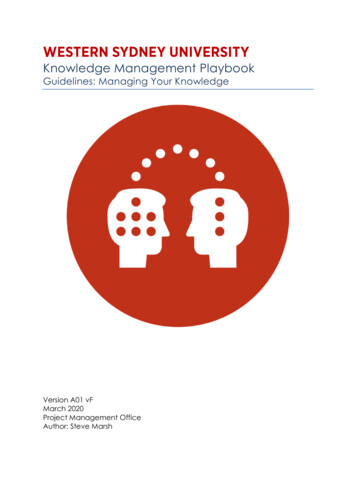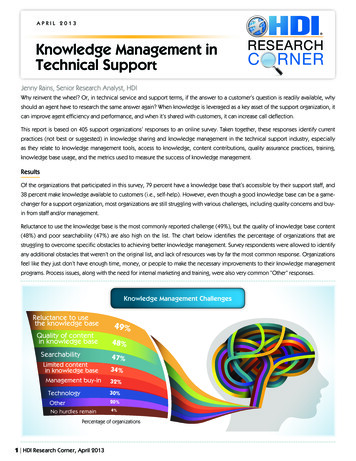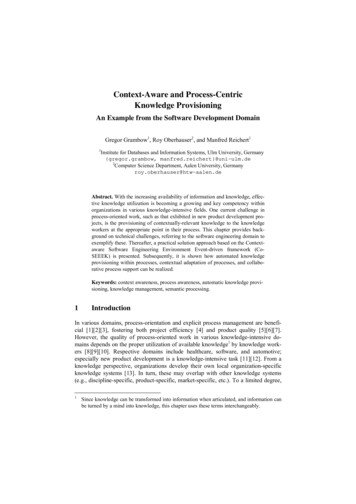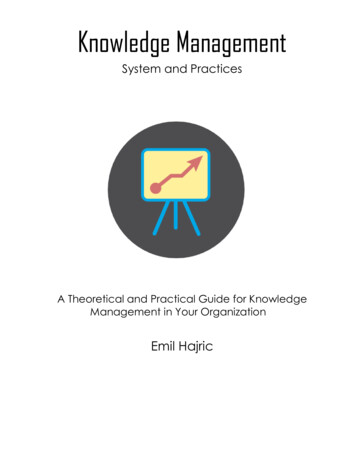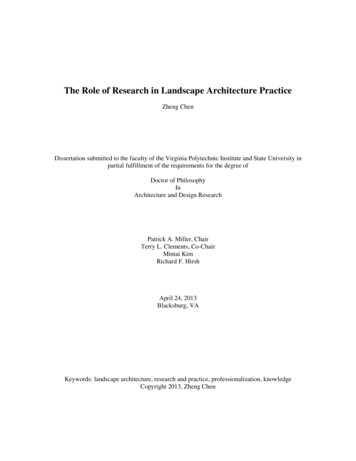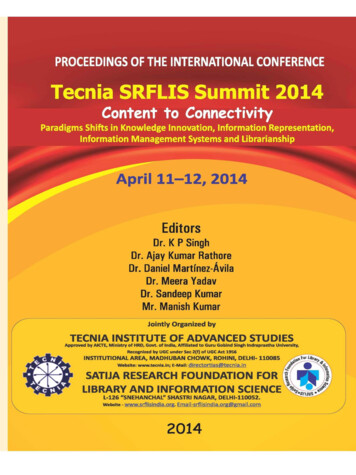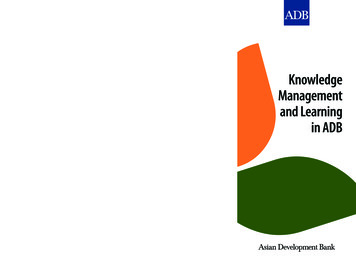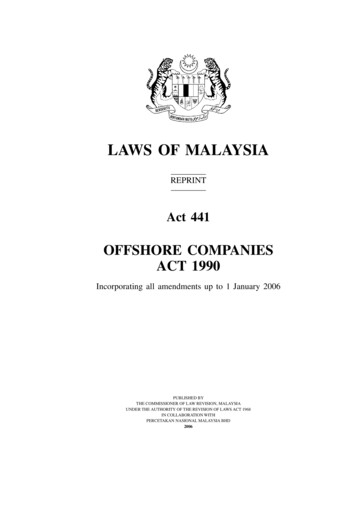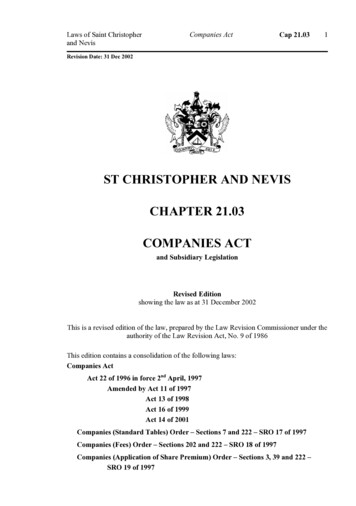
Transcription
Achieving Knowledge-Creating Companies in Mexico: the Advantage of University-Industry AlliancesKarla CedanoCentro de Investigacion en Ingenieria y Ciencias Aplicadas – UAEMCuernavaca, Morelos, 62210, MexicoManuel MartinezCentro de Investigacion en Energia – UNAMConsejo de Ciencia y Tecnologia del Estado de MorelosCuernavaca, Morelos, 62420, MexicoAntonio del RioCentro de Investigación en Energia – UNAMCuernavaca, Morelos, 62580, MexicoandLorenzo MartinezInstituto de Ciencias Fisicas – UNAMCuernavaca, Morelos, 62210, MexicoABSTRACTIn this paper we focused on developing a methodology topromote innovation through industry-university collaboration.So we analyzed two different scenarios. On one hand we havethe traditional firm, that is striving to survive in the globalknowledge-driven economic framework and on the other wehave world class research universities that are trying to find thebest way to put their knowledge in the market place, fosteringspin-offs as well as promoting knowledge transfer to thetraditional industry. We have analyzed the behavior ofsuccessful high-technology spin-offs, and knowledge transferexperiences worldwide. In particular, we have focused on themanagement paradigm of the “knowledge creating company”,proposed by Nonaka [11], since it is one of the models that bestdescribes the organizational environment in such successfulexperiences. Finally, we present the methodology developed asa result of this study that is currently being applied in our StateUniversityKeywords: scientometrics, scientifically generated innovation,knowledge managementINTRODUCTIONOne of the main challenges, that emerging economies face, isthe evolution from its traditional economy to a knowledgeeconomy. It is a well-known fact that Mexico thrives to be partof a knowledge driven economy, where the capacity to supportprocesses of innovation and learning is a key source ofcompetitive advantage. As a matter of fact, innovation has beenrelated to competitive advantage in firms, without regard to thetype or size of the company [3,5].Innovation has been related to competitive advantage in firms,disregarding the type or size of the company [20, 19]. Lueckand Katz [16] define innovation as “the embodiment,ISSN: 1690-4524SYSTEMICS, CYBERNETICS AND INFORMATICScombination, or synthesis of knowledge in original, relevant,valued new products, processes, or services”. Innovationliterature is rich in descriptions and classifications of innovationand innovation dynamics; our main interest relies ontechnological innovation [18, 17].This type of technological innovation needs a strong scientificresearch core, where the expertise of a scientific group providessufficient leverage and confidence around a technologicalsolution, allowing an extraordinary idea to transform into asuccessful innovation. We will call this type of technologicalinnovation, scientifically generated innovation, and it will bethe one this paper is focused on.INNOVATION AND U-I COLLABORATIONHistorically, academic research has focused on basic research[13]. Sometimes, breakthrough ideas from universities would“spill over” to industry. Little effort is being done in this field,universities are not educating industrialists, nor industrialists aretracking academic research, and worst of all, in the case ofdeveloping countries, such as Mexico, there is practically nocommunication between both sectors (or at least not aneffective one). Almost nobody outside the academicenvironment knows what are the areas of research of theregional Universities or research centers. Moreover, thecommunity knows little in general about the specific projectsthey are involved.One of the main challenges faced by developing countries intheir aim to implement scientifically generated innovations isdetecting their thrust areas. Although the countries that areconsidered as technology suppliers face this challenge also, themacroeconomical framework of developing countries raises therisk of technological innovation investment. Governments, andmore specifically science and technology managers (public orprivate), have to take decisions on a regular basis and needVOLUME 8 - NUMBER 2 - YEAR 201029
reliable information on the real strengths of their scientificcommunity, in a global environment. While developingcountries investment on S&T is mainly public, since research isdone by universities or public funded research centers, theirentrepreneurial sectors are distant and skeptic towards thescientific community. These two issues affect negativelyknowledge and technology transfer, which is necessary totrigger technological innovation.Nevertheless, a strong academic environment fosters capacitybuilding in local public and private universities; thus, producinghuman resources prone to the knowledge creation process.However, the successful cases of technology transfer are scarce.In order to overcome the underlying causes of this fact wefocused on finding niches, where the strength on certainscientific area could lead to a technological development, andfurthermore to the generation of wealth around it.In order to analyze the different factors that promote (or not)innovation, we need a representative set of information. Wefocused our study in a small region, the State of Morelos. Wechose Morelos over any other state in Mexico, because itrepresents the most important concentration of scientists inMexico (per capita and per square mile). Its scientificcommunity has established its work and family centers since1975, reaching its most accelerated rate of growth between1985 and 1990. Actually it is considered as a mature, prolificand high-quality scientific community. And, in the last fewyears, we have witnessed the success of university-businessalliances. One of such cases is a very successful Universityspin-off.The scientists’ production is reflected on around seven hundredresearch papers they write each year, which represent 10% ofMexico’s scientific production. Figure 1 shows the productivityof these communities in terms of number of papers published inthe last eleven years. It is important to notice that Morelos hasthe same trend, only one order of magnitude below.Figure 1.Research papers written from 1995 to 2006, both inMexico (dots), and in Morelos (diamonds)This graph seems to indicate a scale free behavior, and hence,the possibility to analyze further this set of information,searching for a power-law behavior, which is necessary to applyParetian statistics, instead of classical Gaussian statistics. Mostor the empirical studies done by the social sciences are based onGaussian statistics, which assume normal distributions,averages, and normal confidence intervals. Such empirical30SYSTEMICS, CYBERNETICS AND INFORMATICSapproaches are not effective for studying co-evolutionarydynamics [10] or extreme events [9] that result in Paretodistributions with fat tails, unstable averages, variance thatapproaches infinity and consequent wider confidence intervals.“Scale-free theories” are used to explain the foregoingdynamics and appear applicable for studying and explaining avariety of organization science phenomena. Cedano et al.showed that scientific production in Mexico, and in Morelos,behaves as power law phenomena [19]. Hence, we were able toapply Paretian statistical analysis to the set of scientificproduction in Morelos.MethodologyAs in many scientometrics analysis we used the ScienceCitation Index database (SCI). This database consists ofselected journal records that included the fields of: authors,titles, journals, author addresses, keywords, abstracts andreferences cited for each paper. Data was extracted from theSCI for this study on Fall 2007, its database extractedinformation from approximately 8,500 of the most prestigious,high impact research journals in the world. We analyzed the keyfields of the citing records: Title, Author, Category, DocumentType, Cited References, and Address.For the science production in Morelos, we downloaded all therecords that satisfied the criteria: ADDRESS containing:(Mexico NOT New) AND Morelos, and dated from 1995 to2006.We performed the bibliometric analysis as presented by Kostoff[1] and added text mining to follow the citation miningmethodology [6]. We restricted the citation miningmethodology to analyze the following data: Prolific authors,Prolific institutions and/or countries, Most cited first authors,Categories most researched, as classified by the Institute ofScientific Information, Number of cites per author; and finally,Most relevant words of the abstracts.With this data set we performed a count of each value.Furthermore, to find relevant words we use the same entropictext mining technique used in citation mining [1] to find themost relevant words occurring in the abstracts of all papers.This technique was proposed by Ortuño [14] based on themeasure of the distance between different occurrences of aword in the text. So, this distance on an abstract was comparedto the standard deviation of all words in all abstracts. Anormalized with the mean standard deviation higher than 1indicates that the distribution of the word within a particularabstract is not random, allowing to determine which words orstring of words can be considered relevant for that particulartext [7]. The reasoning behind this assumption is that thestandard deviation is an indicator analogous to entropy and cansometimes play a role as a measure of order, or disorder in nonphysical systems [8]. The advantage of this particular techniqueis that it does not require a labor-intensive revision of individualtexts to extract the keywords from them, but rather provides aready-made list of the words and strings of words whosedistribution within a text is not random and, therefore, likely tobe significant. Methodologies using similar steps have givengood results in literature base discovery [4].We focused then on the relevant words results that wereanalyzed with two different methodologies: a) through a panelof multidisciplinary human experts, and b) with a statisticalapproach. In previous works, such as Russell [15], the relevantVOLUME 8 - NUMBER 2 - YEAR 2010ISSN: 1690-4524
words are analyzed only by a panel of experts. The accuracy ofsuch analysis strongly depends on the degree of expertise of theconsulted team and the breadth of its multidisciplinarity. In thesearch for an unbiased, less human-dependent approach, wefound a different methodology that took advantage of the Scalefree behavior of the set.So we applied our knowledge on Paretian statistics to rank therelevant words in an automated fashion. We formed 20 differentsubsets of information, collecting data from the Web of Sciencewith each of the relevant words in the field TOPIC, whoseADDRESS contained Morelos and (Mexico Not New). Then,we obtained through our computational tool, the researchcategories for each of the twenty relevant words under analysis.We know that a relevant word should not be context dependent,this is, it has to be a word that has a relevant meaning in as fewcategories of knowledge as possible. More precisely, themajority of research papers that contain a relevant word shouldbe concentrated in as few categories as possible. We are dealingwith Paretian statistics, so we counted the different researchcategories that covered 80% of the research papers on eachsubset. Table 1 reflects the results of such analysis, ordered bynumber of research categories. From the results on this table wecan see that the most relevant words are: STARCH, TOXIN,FILMS and CORROSION. For these four words, we searchedfor the most prolific authors; the results are shown in Table 2.Relevant 171920222323283032Table 1: Relevant Words ordered by the number of categoriesthat cover 80%of the papers written in Morelos that containthem as topicRelevant WordsMost Prolific AuthorsSTARCHBELLOPEREZ, LAAGAMAACEVEDO, EPOSSANI, LDBRAVO, ASEBASTIAN, PJNAIR, PKGONZALEZRODRIGUEZ, JGMARTINEZ, LTOXINFILMSCORROSIONTable 2: Most Relevant Words with its most prolific authors inMorelosNow, we can narrow our search to the pairs (Starch,BELLOPEREZ), (Toxin, POSSANI), (Toxin, BRAVO), RODRIGUEZ), (Corrosion, MARTINEZ). Inthese pairs we could identify Lorenzo MARTINEZ, founder ofCPI, the successful university spin-off; as well as GonzaloGONZALESRODRIGUEZ, one of the research collaboratorsand consultants of CPI.ResultsAs shown earlier, CORROSION is one of the most relevantwords detected with our methodology. So, we analyzed thepapers published under the following criteria: TOPIC:corrosion* OR corrosive*; and ADDRESS: Mexico NOT NewAND Morelos, aiming to find the scientific production of thelast 10 years, done in Morelos, on corrosion. This led us todiscover not only that Martinez is one of the most prolificauthors in Morelos.Figure 2: Mexican institutions conducting research oncorrosion. This results were obtained with the search criteria:TOPIC: corrosion* OR corrosive*; and ADDRESS: MexicoAND Morelos NOT New.In figure 2 we can see the Mexican institutions that conductresearch in corrosion. Once again, UNAM, the institution whereMartinez conducts his research, as well as UAEM, whereGonzalezRodriguez’s group is in close relation with Martinez’s,ISSN: 1690-4524SYSTEMICS, CYBERNETICS AND INFORMATICSVOLUME 8 - NUMBER 2 - YEAR 201031
appear in the top places, accounting for almost 40% of theresearch done in Mexico on this field. Moreover, this graphshows us possible competitors (or strategic alliances, as well) inthe marketplace, since CINVESTAV, IMP, IIE and UAM areall prestigious universities or research centers that are enteringsuccessfully the innovation scenario.THE KNOWLEDGE CREATING SPIN-OFFMartinez founded several years ago CPI, a firm that providesservices of highly specialized technology in anti-corrosionprotection. It also coordinates training and certificationprograms on corrosion, due to his partnership agreement withNACE International (National Association of CorrosionEngineers). His company represents one of the most successfultechnology transfer ventures in the region, with strong strategicalliances with several universities, mainly with UniversidadAutonoma del Estado de Morelos (UAEM).The issue of intellectual property protection was also analyzedin the case of Martinez. CPI is a university spin-off, that in itsbeginning relied on the expertise of its major stockholder,Martinez. As time passed by, and the need for more expertsgrew (along with the sales of the company), Martinez registeredhis methodology and analysis procedures, protecting fromothers the most important asset of his company: knowledge.Furthermore, he has two patents pending in Mexico, forengineering innovations developed entirely by CPI's group ofengineers (all of them graduate students at UAEM, also).Financially, CPI has proven to be successful not only by thegross income it has had in the past 5 years; but also because ithas generated a couple more of firms in this recent period.Hence, conforming a small consortium dedicated to differentmarket shares. The consortium's gross income is represented inFigure 6.Figure 6. Gross Sales (in millions of Mexican pesos) over thepast 4 years (2009 is estimated)CPI s growth is also measured by the size of the company. On2004, it had 6 full time employees, and worked with 11independent consultants from 2 state universities. On 2008, 46people work full time, it has strategic alliances with 5 stateuniversities in Mexico, and it hired the services of more than 50independent consultants from all over the world. Also last year30% of its sales were made to other countries in Latin America.A growth at this rate, both in the economic and scientificarenas, clearly shows the relevance of this study.32SYSTEMICS, CYBERNETICS AND INFORMATICSThe external forces that fostered the spin-offWhile analyzing CPI's creation, we were able to pinpoint aspecific moment where the external conditions aided andpromoted Martinez's venture: The acknowledgement thatCONACyT (National Council of Science and Technology inMexico), gave him as a National Investigator of Excellence,valid from January 2003 through December 2012. Therecognition was given only to 50 scientists. It rewardedMartinez's overall work, not only in the scientific community,but also in the technology transfer arena. This, on one hand, seta standard on how important it was for Mexican authorities todevelop technology transfer experiences, since theacknowledgement includes a monetary prize. But mostimportantly, the financial security it represents, over a period of10 years, relieves scientists of the burden related to increasetheir impact in the short term, giving enough latitude toarticulate medium and long term ventures. When Martinezreceived this recognition, the research center authorities had thevision of fostering this attitude towards entrepreneurialactivities. This openness from the academic authorities is whatwe have named “External force 1”. Since it is a new input to thenormal scientific community environment, where the number ofpapers published in respected journals is mostly, the onlyactivity recognized as productive.So, even though Martinez worked as an independent consultantsome time ago, the academic and productive sector dynamicswere out of sync. This lack of timing translated on a fairly goodproductive relationship, but limited in time to the researchuniversity agenda and in scope to the legal universityframework. It was not until the manifestation of the “Externalforce 1” that this small group of scientists and managers weredriven to enable the generation of a spin-off that could provideservices to the industry, without the disadvantages of theacademic dynamics. As the company grew, they kept onfulfilling the increasing need for innovation that the market had,in their area of expertise.Then we followed the history of this spin-off as it began togrow, and how a second external force led this company todevelop a knowledge-creating environment. Moreover, as thisspin-off faced the need to increase its market share, wepinpointed its influence in other research universities, as anexternal force to them, to foster a knowledge creating ambientin those universities as well. While analyzing the organizationalculture at CPI, we clearly found a direct association betweenNonaka's proposal of “knowledge creating company” [11] andthe operation at CPI. Furthermore, this organizational culturewas shared with their customers (oil transport Mexicanindustry) as well as their providers (state universities andresearch centers).Nonaka identifies three elements in his model [12]: The SECI (Socialization, Externalization, Combination andInternalization) process, that stands for the conversion oftacit and explicit knowledge in different moments of theknowledge creating process. Socialization: transformation of tacit to tacitknowledge, by empathizing among peers. Externalization: transformation of tacit to explicitknowledge, by articulation while producing drafts, Combination: transformation of explicit to explicitknowledge, by connecting different organization areasand levels. Internalization: transformation of explicit to tacitknowledge, by embodying knowledge, making itVOLUME 8 - NUMBER 2 - YEAR 2010ISSN: 1690-4524
“personal”.'Ba', the context also known as the time and space whereSECI occurs. The research center infrastructure (physicaland virtual).The knowledge assets, the set of inputs, outputs andmoderators of the knowledge creating process.The way these three elements interact and conform aknowledge-creating platform resembled clearly the wayscientific research is done in our culture. Several studies haveshown the relevance of culture as well as the individuals’capacity to communicate, this being critical in the processing oftacit knowledge. Our academic community relies strongly onthe continuous transformation of tacit and explicit knowledge.Socialization, Externalization, Combination and Internalizationare common processes that take place on our research centersdaily, while interacting among peers; communicating findingsand protocols; elaborating research papers; on internal andexternal congresses and seminars; and while learning from thelatest breakthroughs as well as the reference literature;respectively.When Martinez began the process of spinning off, he was ableto do by himself the basic management of the small firm. Hisexperience as former director of the Center of Physic Sciences(the research center he's been working for, during the last 20years, now Institute) was a valuable asset in the process. So,when Martinez changed of scenario, he followed his years oftraining as a lead researcher and replicated this well knownorganizational culture in his company.He fostered a well-balanced ba, where employees, consultants,customers and providers were free to interact, comfortably andopenly. Since he started as the sole moderator of a very smallcompany, he managed to maintain the perfect environment forknowledge creating. Also, he began working for formerresearch collaborators that had left the scientific scenario, to bepart of the productive sector, thus being able to maintain theclimate of trust, openness and communication, indispensable forknowledge creation to take place. Moreover, he did not hire theexperts but, sensible to the academic dynamics and legalrestrictions, he formed strategic alliances with the stateuniversities as a whole, promoting the development of qualifiedhuman resources (graduate students), as well as promotingspecific research areas that were pertinent and closely relatedwith the customers problematic at hand.However, as CPI began to grow; and hence, the complexity ofthe relationships with its costumers, employees and providers, itfaced one of the most crucial challenges that companies face,the definition of its organizational culture. He hired amanagement consultant to organize the growing company hehad been managing by himself. The consultant had never faceda high-technology company, where the most valuable asset isknowledge. He tried to impose a more restrictive, traditionalmanagerial style. Attention was paid to expenses, income, hoursspent in the working place or with customers; disregarding thefriendly, trustworthy environment CPI used to have. Excessiveregulation on everyone’s time and whereabouts at the firmpromoted a negative working climate.Fortunately enough, the trust, care and commitment of most ofthe employees at CPI, as well as the continuous communicationbetween them and Martinez, stopped the transformation of theknowledge-creating environment to a traditional, rigid, overcontrolled one. At the same time this crisis was starting, CPIwas investing on a research project on knowledge andISSN: 1690-4524SYSTEMICS, CYBERNETICS AND INFORMATICStechnology transfer. So Martinez received continuous inputabout different management methodologies. In particular, theproject focused on Nonaka’s knowledge creating company, dueto the similarities found with CPI. Once Nonaka's theory waspresented to Martinez, he decided to reinstall the former way ofdoing things at his company, with a clearer framework in mind.We identify this as “External force 2”. He reoriented themanagement consultant towards the accounting and taxdepartments, and established clearly the roles and functions ofeveryone in the company, in a non-restrictive way. Specialattention was put to promoting a better ba, both physical andvirtual. Today, CPI s headquarters are nicely decorated, open,comfortable and foster spaces where interaction between allemployees is promoted. All managers are convinced that CPI isa knowledge creating company, and their main concern is tokeep communication flowing. The elaboration of manuals,reports, web pages, and logbooks is a process that involvesseveral individuals, since every piece of information isproduced by the expert technician, revised by a couple of hispeers, edited by communication experts, and stored in thegeneral repository which everyone is encouraged to consult andimprove.BIOTECHNOLOGY AND ITAs we stated before, another important target of this researchwas to propose a methodology to promote innovation forestablished firms. First of all, to find thrust areas in Morelos, weapplied data mining techniques to the scientific production ofour state research centers, finding that Biotechnology and IT aretwo such areas. So we searched worldwide for successful hightech companies in the biotechnology and IT sector that werefocusing their attention on the knowledge-creating companymodel.In the Biotechnology area, its knowledge intensiveness hasdriven different industries towards a knowledge-nurturingscheme. For instance, the Finnish food industry [20], realizingthe need to innovate, has turned its attention to functional foods.The external forces that drove this initiative are bothtechnological and market-based. On one side, there is a marketdemanding better healthier and more nutritious food (alsoknown as functional food), this market need has to be met by afood industry that didn’t use to focus on such detailedinformation regarding their products. On the other hand,biotechnology is turning low-technology industries into hightechnology industries rapidly. These two of factors act togetheras an external force or driver of change. The success of thisstrategic change depends mostly on the ability to take necessaryactions for creating new knowledge. These changes haveimplications for both strategic decision-making and knowledgemanagement processes. Since this industry’s best course ofaction is to enable partnerships with biotechnology companies,instead of investing heavily on R&D (which has not been donein the past), knowledge needs to be well managed not onlyinside each firm, but also between biotechnology companiesand research centers, among others.Another example can be found in the pharmaceutical industry[21], since it is knowledge intensive sector. In this industry,innovation is the key element for success, not only in thebiotechnology area, but also in the communications one. As amatter of fact, virtual networks have recently been the onlyfeasible alternative to encourage new product development.Hence, careful management of information, robust informationVOLUME 8 - NUMBER 2 - YEAR 201033
systems, collaborative virtual environments, and securecommunication channels, are some knowledge assets necessaryto take into consideration while establishing a knowledgemanagement framework. Once more, the market pressure forbetter, harmless, more specific drugs; as well as thecompetitors’ ability to foster in-house innovation, has ledsmaller pharmaceutical companies to engage in strategicalliances with university research centers. Thus, emphasizingthe importance of establishing knowledge-creating frameworksthat hold this type of collaboration.The IT industry poses a greater challenge. Information is theonly asset of this industry. Notwithstanding the different sectorit attends, this industry needs a strong, robust and trustyrelationship with its customers.It is through intensivecommunication with them and with the latest breakthroughs thatbetter, more competitive products are developed. Dayasindhu[22] pinpoints the productivity increase that the Indian softwareindustry achieves by focusing on innovation and growth. Thus,there is a pressure (external force) from a market that demandsmore flexibility and specificity. This pressure is driving the ITIndian industry towards creating trust and encouraging intra andinter organization relationships. So, the faster they adoptknowledge creating environments the better they will face thechallenge this more demanding market represents.In this case, we highlight two external forces as well; one thataccounts for the decision to modify the company's environment,and another that determines the need to adopt a knowledgecreation environment, in the sense described by Nonaka. Webelieve that the more this environment follows the modelproposed by Nonaka, the better these companies will fosterknowledge sharing, the most important process for theknowledge-creating company.FINAL RESULTSThe analysis of these experiences led us to develop amethodology to help both traditional industries and universities'spin-offs to achieve an organizational culture of knowledgemanagement, through the establishment of strategic allianceswith the universities where the experts of their fields of interestdo their research. Our methodology includes the application ofdata mining and bibliometrics on scientific paper databases forthe detection of both experts and scientific thrust areas thatmight have a higher chance to generate successful hightechnology spin-offs.Our MethodologyTo promote spin-offs from the University or Research Center:1. Application of scientometric analysis over the region ofinterest (geographic, institutional, thematic, etc.) toidentify opportunity niches.2. Implementation of institutional stimuli as “externalforce 1” events that promote entrepreneurial activity inthe niches identified in 1.3. Training on knowledge-creating organizational cultureto the entrepreneurial team.4. Unlimited access to technology transfer specialists ting, legal, and any other matter not related tothe expertise of the entrepreneurial team.To promote innovation in established firms:1. Training on knowledge-creating organizational culture34SYSTEMICS, CYBERNETICS AND INFORMATICSby experts in technology/knowledge transfer in thefirm's area of expertise.2. Articulation of thematic meetings with experts from theacademic sector, where tacit and explicit knowledge isshared. These experts have to be trained in knowledgecreating organizational culture as well.3. Depending on the
successful innovation. We will call this type of technological innovation, scientifically generated innovation, and it will be the one this paper is focused on. INNOVATION AND U-I COLLABORATION Historically, academic research has focused on basic research [13]. Sometimes, breakthrough ideas from universities would

